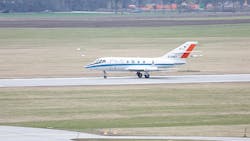German Aerospace Center tests digital communications technologies combined with additional navigation functions for the first time
"In principle, LDACS for aviation works in a similar way to mobile radio communications on the ground," explains Michael Schnell, from the DLR Institute of Communications and Navigation in Oberpfaffenhofen, where the new technology has been undergoing development with external partners since 2007. "The ground station corresponds to the mobile phone base station, and the radio in the aircraft corresponds to the smartphone."
The new technology, with which pilots and controllers can benefit from improved communications, enables both high-quality voice transmissions and fast data exchange.
"The particular challenge was that no new frequencies could be made available for this digital service," explains Christoph Günther, Director of the DLR Institute for Communications and Navigation. "It was thus necessary to develop procedures to enable the operation of this service in parallel with other services in the same frequency band."
Related: German Aerospace Center developed de-icing technology using carbon fiber
DLR notes that with LDACS, pilots and air traffic controllers will be able to communicate more efficiently and will be able to provide precise locations for the aircraft by determining its distance from at least four ground stations.
"If the signals from the GPS or Galileo satellites are unavailable for any reason, the pilots would still be able to find their precise location via LDACS," says Schnell. "This creates an additional margin of safety."
While DLR will besting the LDACS equipment soon, the organization said it will take a few years before the technology is adopted.
"Once the standard is finalised, manufacturers and airlines will be encouraged to adopt it," explains Michael Schnell. "This should happen by 2022."
Ready to make a purchase? Search the Intelligent Aerospace Buyer's Guide for companies, new products, press releases, and videos
